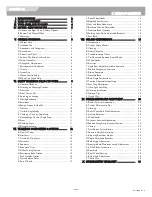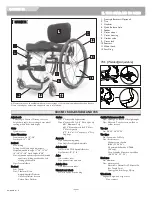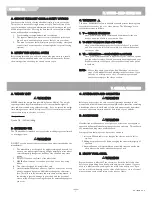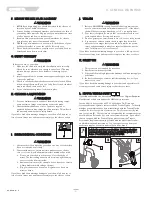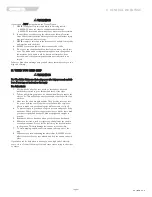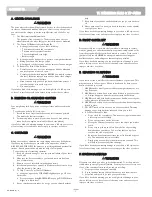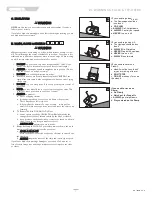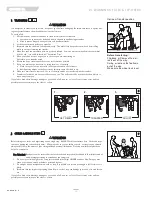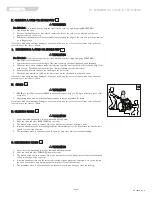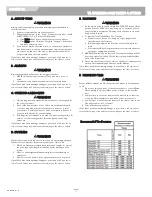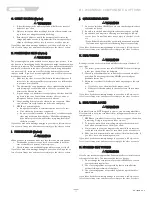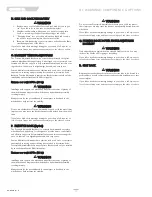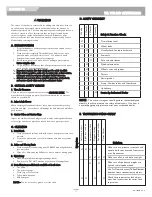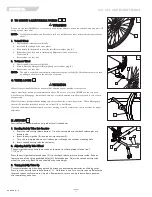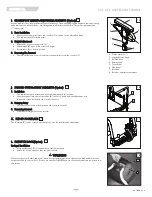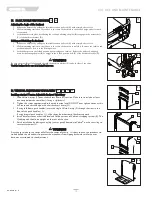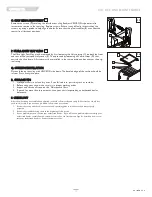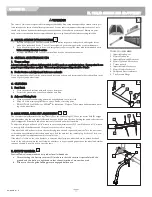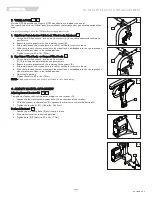
MK-100084 Rev. A
6
Q UI C KI E 7 R
V. GENERAL WARNINGS
J. TERRAIN
WARNING
1.
Based on ANSI/RESNA testing, Sunrise Medical recommends the
use of a caster wheel with a minimum diameter of 5”, if the wheel-
chair will be overcoming obstacles up to 1/2” on a regular basis.
2.
Your chair is designed for use on firm, even surfaces such as con-
crete, asphalt, indoor flooring, and carpets.
3.
Do not operate your chair in sand, loose soil, or over rocky terrain.
4.
If you use your chair on terrain that is rougher than described
above there is a danger that screws and bolts will loosen prema-
turely, and that damage to wheels or axles could put the rider at
risk of a fall, tip-over, or loss of control.
If you fail to heed these warnings damage to your chair, a fall, tip-over or
loss of control may occur and cause severe injury to the rider or others.
K. STREET USE
WARNING
1.
This product is not intended for street use.
2.
Avoid streets whenever possible.
3.
Obey and follow all legal pedestrian pathways, and laws that apply to
pedestrians.
4.
Be alert to the danger of motor vehicles in parking lots, or if you
must cross a road.
If you fail to heed this warning, damage to your chair, and a possible colli-
sion may occur and cause severe injury to the rider or others.
L. MOTOR VEHICLE SAFETY
If possible and feasible, the rider should transfer to the Original Equipment
Manufacturer vehicle seat and use the OEM vehicle restraint.
Sunrise Medical does provide a WC-19 Wheelchair Tie-Down and
Occupant Restraint System, otherwise called a Transit Option. To Identify
whether your wheelchair has been manufactured with the Transit Option
installed, look for four points of securement. Two Front points, (A) and
two rear points (B). These points are recognized by the securement point
decal which can be found on or near the securement points. If you wheel-
chair is equipped with the Transit Option please review the Transit
Securement supplement that was provided with the wheelchair for addi-
tional information and instructions. You can request a copy from your
authorized supplier, or Sunrise medical if you don’t have it.
2
1
F. REDUCE THE RISK OF AN ACCIDENT
WARNING
1.
BEFORE you begin riding, you should be trained in the safe use of
this chair by your health care advisor.
2.
Practice bending, reaching and transfers until you know the limit of
your ability. Have someone help you until you know what can cause
a fall or tip-over and how to avoid doing so.
3.
Be aware that you must develop your own methods for safe use
best suited to your level of function and ability.
4.
NEVER try a new maneuver on your own. Ask the advice of your
health care provider to lower the risk of a fall or tip over.
5.
Get to know the areas where you plan to use your chair. Look for
hazards and learn how to avoid them.
G. SAFETY CHECKLIST
WARNING
Before each use of your chair:
1.
Make sure the chair rolls easily and that all parts work smoothly.
Check for noise, vibration, or a change in ease of use. (This may
indicate low tire pressure, loose fasteners, or damage to your
chair).
2.
Inspect any problem. Your authorized supplier can help you find and
correct the problem.
3.
Check to see that both quick-release rear axles are locked. When
locked, the axle button will “pop out” fully. If not locked, the wheel
may come off and cause you to fall.
4.
If your chair has anti-tip tubes, lock them in place.
H. CHANGES & ADJUSTMENTS
WARNING
1.
See your healthcare advisor and have them adjust seating compo-
nents any time a change or adjustment needs to be made.
2.
Unauthorized modifications or use of parts not supplied or
approved by Sunrise may change the chair structure. This will void
the warranty and may cause a safety hazard.
If you fail to heed these warnings damage to your chair, a fall, tip-over or
loss of control may occur and cause severe injury to the rider or others.
I. ENVIRONMENTAL CONDITIONS
WARNING
1.
Use extra care if you must ride your chair on a wet or slick surface.
If you are in doubt, ask for help.
2.
Contact with water or excess moisture may cause your chair to
rust or corrode. Avoid all extreme weather situations if possible.
a. Do not use your chair in a shower, pool or other body of
water. The chair tubing and parts are not water-tight and may
rust or corrode from the inside.
b. Avoid excess moisture (for example, do not leave your chair in
a damp bathroom while taking a shower).
c. Dry your chair as soon as you can if it gets wet, or if you use
water to clean it.
If you fail to heed these warnings damage to your chair, a fall, tip-over or
loss of control may occur and cause severe injury to the rider or others.
Look for this symbol on your wheelchair. It indicates wheelchair
securement points which conform to ANSI/RESNA (1998) V.1 –
Section 19 & ANSI/RESNA (2012) V.4 WC-19.
1
2
A
B



